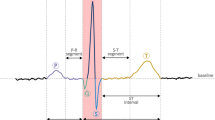Abstract
Electrocardiograms (ECGs) use electrodes to monitor heart rates and discover tiny electrical changes in each beating. This test can detect abnormal cardiac activity such as arrhythmias and conduction abnormalities. The goal of this research is to offer a method for analyzing and classifying the six micro-classes of cardiac variations found in the MIT-BIH arrhythmia database. Normal (NOR), Left Bundle Branch Block (LBBB), Right Bundle Branch Block (RBBB), Atrial Premature (AP), Premature Ventricular Contraction (PVC), and others (/) are the classifications. The wavelet transform is used to pre-process the input signals, and the peak detection technique is used to identify the R peaks. After preprocessing, oversampling is conducted on the underrepresented classes to improve feature learning by the Convolutional Neural Network(CNN).CNN has 15 levels that are used to process the input. The model achieves a 99.42 accuracy rate.





Similar content being viewed by others
Data availability
The data will be made available upon request.
Abbreviations
- CNN:
-
Convolutional neural network
- ECG:
-
Electrocardiogram
- NOR/N:
-
Normal heartbeat
- AP/A:
-
Atrial premature
- PVC/V:
-
Premature ventricular contraction
- LBBB/L:
-
Left bundle branch block
- RBBB/R:
-
Right bundle branch block
References
Mendis S, et al. Global atlas on cardiovascular disease prevention and control. Geneva: World Health Organization; 2011.
Junli Gao et al. An effective LSTM recurrent network to detect arrhythmia on imbalanced ECG dataset. J Healthc Eng. 2019;2019.1:6320651.
Guo S-L, et al. The future of remote ECG monitoring systems. J Geriatr Cardiol: JGC. 2016;13(6):528.
Homaeinezhad MR, et al. ECG arrhythmia recognition via a neuro-SVM-KNN hybrid classifier with virtual QRS image-based geometrical features. Expert Syst Appl. 2012;39(2):2047–58.
Kandala RN, et al. Towards real-time heartbeat classification: evaluation of nonlinear morphological features and voting method. Sensors. 2019;19(23):5079.
Kiranyaz S, Ince T, Gabbouj M. Real-time patient-specific ECG classification by 1-D convolutional neural networks. IEEE Trans Biomed Eng. 2015;63(3):664–75.
Li Q. Medical image classification with convolutional neural network. In 13th international conference on control automation robotics & vision (ICARCV). IEEE. 2014;2014:844–8.
Li T, Zhou M. ECG classification using wavelet packet entropy and random forests. Entropy. 2016;18(8):285.
Luz EJDS, et al. ECG arrhythmia classification based on optimumpath forest. Expert Syst Appl. 2013;40(9):3561–73.
Celin S, Vasanth K. ECG signal classification using various machine learning techniques. J Med Syst. 2018;42(12):241.
Alfaras M, Soriano MC. A fast machine learning model for ECG-based heartbeat classification and arrhythmia detection. Front Phys. 2019;7:103.
Wu M, et al. A study on arrhythmia via ECG signal classification using the convolutional neural network. Front Comput Neurosci. 2021;14:564015.
Ojha MK, et al. Automatic detection of arrhythmias from an ECG signal using an auto-encoder and SVM classifier. Phys Eng Sci Med. 2022;45(2):665–74.
Sepahvand M, Abdali-Mohammadi F. A novel method for reducing arrhythmia classification from 12-lead ECG signals to single-lead ECG with minimal loss of accuracy through teacher-student knowledge distillation. Inf Sci. 2022;593:64–77.
Ruben Enrique Ca ̃n ́on-Clavijo et al. IoT based system for heart monitoring and arrhythmia detection using machine learning. J Healthc Eng 2023;2023.1:6401673.
Zhuang T, et al. DAMBLO: improving arrhythmia classification with plug-and-play dual attention-based multiscale feature learning block. In: Available at SSRN 4633304 ().
Kumar S, et al. Fuzz-ClustNet: coupled fuzzy clustering and deep neural networks for Arrhythmia detection from ECG signals. Comput Biol Med. 2023;153:106511.
Martis RJ, et al. Application of higher order cumulant features for cardiac health diagnosis using ECG signals. Int J Neural Syst. 2013;23:1350014.
Moody GB, Mark RG. The impact of the MIT-BIH arrhythmia database. IEEE Eng Med Biol Magaz. 2001;20(3):45–50.
Bazi Y. Domain adaptation methods for ECG classification. International conference on computer medical applications (ICCMA). IEEE. 2013;2013:1–4.
Ahlstrom ML, Tompkins WJ. Digital filters for real-time ECG signal processing using microprocessors. IEEE Trans Biomed Eng. 1985;9:708–13.
Rajendra AU, et al. A deep convolutional neural network model to classify heartbeats. Comput Biol Med. 2017;89:389–96.
Rajendra AU, et al. Application of deep convolutional neural network for automated detection of myocardial infarction using ECG signals. Inf Sci. 2017;415:190–8.
Masko D, Hensman P. The impact of imbalanced training data for convolutional neural networks. 2015
Awal MA, et al. An adaptive level dependent wavelet thresholding for ECG denoising. Biocybern Biomed Eng. 2014;34(4):238–49.
Acknowledgements
The authors would like to thank the Advanced Manufacturing Technology Development Center for valuable scientific discussions.
Funding
This research was conducted without any external funding.
Author information
Authors and Affiliations
Corresponding authors
Ethics declarations
Conflict of Interest
On behalf of all authors, the corresponding author states that there is no Conflict of interest.
Ethics approval
This research complies with ethical guidelines by not including human or animal participants.
Additional information
Publisher's Note
Springer Nature remains neutral with regard to jurisdictional claims in published maps and institutional affiliations.
Rights and permissions
Springer Nature or its licensor (e.g. a society or other partner) holds exclusive rights to this article under a publishing agreement with the author(s) or other rightsholder(s); author self-archiving of the accepted manuscript version of this article is solely governed by the terms of such publishing agreement and applicable law.
About this article
Cite this article
Mishra, U., Golchha, P., Jegaraj, J.J.R. et al. An ECG Based CNN Model for Detection of Different Classes of Arrhythmia. SN COMPUT. SCI. 5, 661 (2024). https://doi.org/10.1007/s42979-024-02951-w
Received:
Accepted:
Published:
DOI: https://doi.org/10.1007/s42979-024-02951-w




